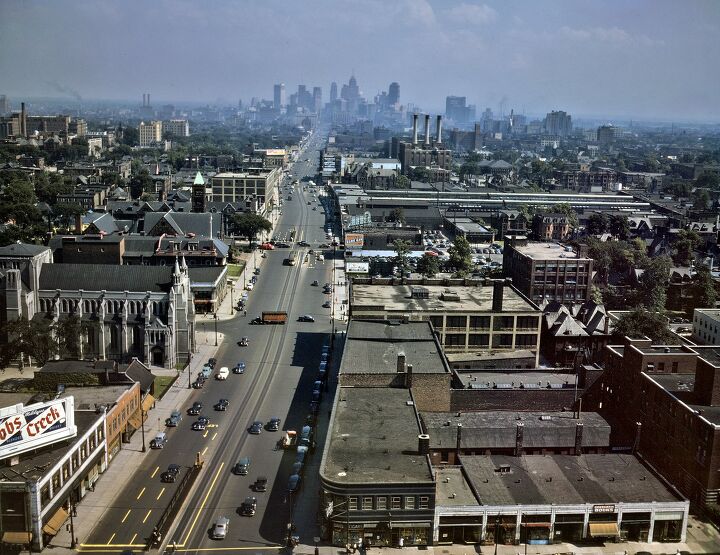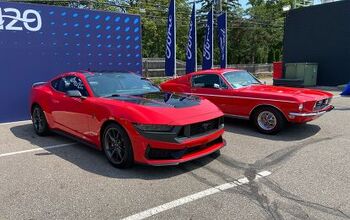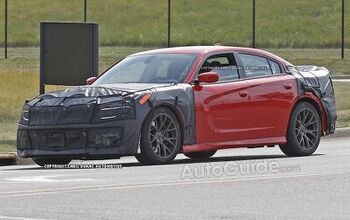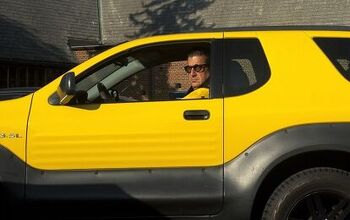Detroit, Race, And The Woodward Dream Cruise

One of the reasons why I started writing for TTAC was that, as a lifelong resident of the Detroit area I was tired of watching people with little direct knowledge of this region using stereotypes and caricatures to demean my neighbors. Typically people outside the region will describe Southeastern Michigan as a place of unemployment, indifferent workers, crime and racial disharmony. As with most prevarication, there’s an element of truth to those stereotypes, but it’s not the whole truth.
I can understand finding that kind of behavior in comment threads online, but it’s distressing when what is generally considered the leading newspaper in the country, the New York Times, lazily relies on a ‘usual Detroit template’ when covering an event in this area.
On the day before the official Woodward Dream Cruise, the NYT’s Wheels blog, had an article by Mary Chapman titled Motor City’s Woodward Dream Cruise Remains a Suburban Affair. Though the headline referred to geography, a supposed city/suburbs conflict, Chapman didn’t even make it out of her second paragraph before describing the region as “riven with racial strife”. Chapman does acknowledges that the Dream Cruise is a feel good event for most people in the region and that many people in the region, regardless of ethnicity, love cars. However, it’s clear to me that the point of Chapman’s piece really was to imply there was some kind of nefarious racial motivation for the Dream Cruise’s route, which never actually goes inside the city limits of Detroit. Chapman writes, “the cruise’s avoidance of the Motor City seems odd to some, alienating to others.”
So the only two choices are odd or alienating. Chapman proceeded to interview Detroit area blacks for their thoughts on the subject.
Chapman didn’t bother to interview the Dream Cruise’s original organizers and never gets deeply into the history of cruising on Woodward, which commenters to her article pointed out is the main reason for the route going where it goes.
Detroit is located on the Detroit River, which flows in a southwest direction (at Detroit, Canada is due south of the US). City planners laid out a neat north-south east-west grid for most of the streets, overlaid with a number of major roads radiating out from close to the river. The center spoke is Woodward Ave, which runs from the foot of the river north all the way out to Pontiac in north Oakland County. Just before Woodward exits Detroit, the street beomes boulevarded, with a wide center island and the traffic is widened to at least four lanes in each direction. From the 1950s into the early 1970s, there was a string of drive-ins and other teen hangouts starting around Nine Mile Rd in Ferndale and ending at Ted’s Restaurant out near Pontiac. Teenagers would usually take the family car, fill it with their friends, and cruise the 14 miles or so, back and forth between Ferndale and Ted’s, stopping at the various hangouts as they pleased. The multiple lanes meant they had their choice of cruising sedately in the curb lane or going faster (including street racing) in the left lanes. The fact that the road is a boulevard with numerous “Michigan turnarounds” meant that the drivers could just loop around all night long.
Starting in the late 1960s, though, municipalities started cracking down on cruising. Street racing had gotten pretty serious. Detroit being the locus of the American auto industry, there were even unofficial factory street racing teams, like the Mopar guys who ran the Silver Bullet on Woodward. Speeding and noise tickets started proliferating and some of the municipalities passed anti-loitering ordinances which made hanging out in drive-in parking lots illegal. Also, by the 1970s, youth culture was moving away from hod rods and sock hops to hippies and psychedelics. By the middle of the decade, most of the drive-ins were out of business and cruising and street racing on Woodward became of thing of the past.
Fast forward a couple of decades and those teens with their hot rods were now middle aged and affluent enough to afford special interest cars. Also, they were no longer punk teens but rather stalwarts of their communities and upstanding citizens. A group of those enthusiasts got the idea for a modern cruise on Woodward as a fundraiser for youth soccer and in a true grass roots bottom up method, the Woodward Dream Cruise developed into the biggest one day automotive event in the world. Estimates say up to 1.5 million people attend to see about 40,000 cars. Vintage, custom and special interest automobiles and motorcycles don’t just clog the cruising lanes. Parking lots and easements that line Woodward are also filled with cool cars and bikes. The WDC had become so big, in fact, that it has unofficially become a week long event. Actually, because of hotels being booked up for the Cruise, events have stretched to more than a week before the official cruise. The American Motors Owners Club had its national meet in Livonia late last week. The meet included a two hour cruise on Woodward.
In some years past, there have been Dream Cruise related events within the Detroit city limits. For a few years there was a car show at the State Fair grounds, and I believe that last year there was a car show downtown, near the river, so it’s not like the organizers have ignored Detroit. However, the primary reasons why the Dream Cruise route never goes south of Eight Mile have to do with the layout of the road (it’s hard to cruise on a street that is not a boulevard and most of Woodward inside of Detroit has no divider) and the history of cruising on Woodward. Back in the day, kids didn’t really cruise much south of Nine Mile Rd., much less Eight Mile. There just weren’t any drive-ins and hangouts that far south.
As I said above, from the article it doesn’t appear that Chapman bothered to talk to anyone involved with creating the original Dream Cruise route (three years ago the original organizers sold the event to a corporate event planner) or cruisers of any other ethnicity than African-American. Instead, Chapman went out searching for racial animus by talking to its alleged victims, black car enthusiasts
The problem is that despite her attempted slant, most of the African-Americans she spoke with didn’t really see the Cruise and its route as being racially inspired.
Chapman, to her credit, does point out that the route includes Pontiac, a city that’s at least half black and has a black mayor, but she also notes that Pontiac’s representative to the Dream Cruise is the only African-American on their board. Much as she strains to make the Dream Cruise a racial thing, she provided little evidence other than suspicions. At least a couple of the black car enthusiasts she interviewed indicated that they had, indeed, participated in the Woodward Cruise. Both Ron Scott, a community organizer, and Detroit Mayor Dave Bing said that it would be good for the Cruise and the region if more blacks participated, but neither indicated that they thought there was any racial animus by Cruise organizers.
Scott’s comments, to me, argue against the point Chapman is inferring:
- “It’s not a question of whether black people mind crossing Eight Mile, because many do,” said Mr. Scott, now a community organizer in Detroit who has helped to set up small car clubs. “It’s just the fraternity and exchange of culture that you get with these other activities that allows enjoyment of more than just the car. It’s not really that we don’t feel welcome.”
- In fact, he added, many blacks participate in both the Cruise and in predominantly black gatherings of enthusiasts.
Only one person Chapman interviewed even came close to saying that the Dream Cruise route was racially inspired. Michael Farrow, a Detroit business owner who treasures his 1962 Impala ragtop expressed his reservations. “There has to be some hidden agenda why it doesn’t cross Eight Mile. I don’t hear anybody telling us to come on down.”
Just as Seinfeld’s Uncle Leo saw every slight in his life as anti-semitism, so too are some American blacks automatically suspicious of racism.
Actually, contrary to Farrow’s suspicions, Rev. Douglas Jones, Pontiac’s representative to the Dream Cruise board of directors, says that the event has genuinely reached out to black car enthusiasts. According to Chapman, Rev. Jones described the Cruise as inclusive and that the board has encouraged participation from predominantly black car clubs.
Because of the NYT’s article, when I went over to Woodward to watch the people and cars on Friday, the day before the official cruise, I made a point of asking blacks attending the event if they felt unwelcome, or thought there was anything racial in the cruise’s route. I’m not saying that I performed a scientific survey, but I did speak to about a dozen black car lovers who insisted to a person that if there’s one hobby or special interest that has nothing to do with race, it’s about cool machines with go-fast buttons. Not one felt unwelcome and they all agreed that the New York Times unfairly tarred the event in specific and Detroit in general. As one man smilingly told me, “Can’t we all just get along?”
I can’t help but wonder, if Chapman did a story about summer cruising on Belle Isle, an island park on the Detroit River, popular with city residents, if she would note the pronounced lack of anyone but black people.
Addendum:
I used to give Robert Farago a hard time for sniping at Autoblog and other car sites. I thought it was below TTAC’s normal standards and somewhat self-serving to attack the competition. Sometimes, though, a post at another site, as with the NYT Wheels blog discussed above, demands comment.
In its early coverage of the WDC on Thursday, Jalopnik had a story Poorly-Worded Historical Markers Connect Woodward Dream Cruise To Its Past posted by Ben Wojdila. Ben is a good writer with a sensitive approach to Detroit and unfair criticism thereof, but I think this post feeds into that unfair criticism.
Apparently, WDC cruise organizers and sponsors had installed 20 painted signs indicating historic cruising sites that no longer existed. One of the defunct businesses was the “White Cruiser Drive In”.
I like Jalop and have cordial relations with Ray Wert, Murilee Martin and other Jalopnik staff members. Sometimes, though, I get the impression that their Gawker corporate overlords insist on a quota of articles that make it clear that their sites do not approve of anything that is either racist or could be somehow remotely twisted into being racially insensitive.
I don’t know how the sign could have been worded any better without bowdlerizing the restaurant’s name.
Had Jalopnik decided to look into the story beyond just publishing a snarky post, they would have found out that the White Cruiser had an important role in the history of Woodward and cruising on that famous street.
The White Cruiser drive-in was, according to the Ferndale Historical Society [ PDF], the second oldest drive-in on Woodward, the oldest being the legendary Ted’s up by Square Lake Road, near Pontiac. Those teen hangouts at its terminal ends defined the traditional Woodward cruising route. I suppose it’s possible that in the racially insensitive 1940s and 1950s that the restaurant’s name had a racial implication, but if Mr. Farrow can suspect a hidden racial agenda in the Dream Cruise route, I’m entitled to guess that the restaurant was named after a white car.

Ronnie Schreiber edits Cars In Depth, the original 3D car site.
More by Ronnie Schreiber
Latest Car Reviews
Read moreLatest Product Reviews
Read moreRecent Comments
- Ger65691276 I would never buy an electric car never in my lifetime I will gas is my way of going electric is not green email
- GregLocock Not as my primary vehicle no, although like all the rich people who are currently subsidised by poor people, I'd buy one as a runabout for town.
- Jalop1991 is this anything like a cheap high end German car?
- HotRod Not me personally, but yes - lower prices will dramatically increase the EV's appeal.
- Slavuta "the price isn’t terrible by current EV standards, starting at $47,200"Not terrible for a new Toyota model. But for a Vietnamese no-name, this is terrible.


































Comments
Join the conversation
As a life-long suburban resident of the Detroit area, I agree 100% that your article needed to be written. In fact, I wish the NYT had the balls to publish it in response to their article. One thing that should also be mentioned. During the heyday of the cruising Woodward era, many of the cruisers came from south of Eight Mile (Detroit City limits) to cruise in the suburbs north of Eight Mile. Up until the early 70s, many residents in the Detroit neighborhoods near Woodward were predominantly white. The "white flight", as it was called, didn't really start until the late 60s (after the riots) and did't go into full-swing until the mid-70s. So the WDC route is based on the history of what everyone remembers as the true route. It's one of the reasons that the Thirteen Mile intersection is the epicenter of it all with the biggest traffic-jam and foot traffic. It's why parking costs the most there. Including the city of Detroit in the festivities makes the whole thing seem artificial and contrived. There are plenty of blacks, residents and non-residents of Detroit-proper, that not only attend the WDC, but are out there ever weekend all summer long. They are never made to feel unwelcome. Car people (real car people) are car people. The color ever discussed is the color painted on the car. Also, since you mentioned it, cruising on Belle Isle is not really a car-related event. I've been there and that is a place that no real car guy feels welcome. It's more a gathering of thug-life and other sorts that cruise Belle Isle. Most of the crime that happens there, during their cruising, goes unreported. If it was about the cars it would be much different, but unfortunately it's not. Woodward summer cruising is all about the cars. That's what makes it what it is.
Unfortunately, NYT's is a legend only in its own mind. It has long since given up any real credibility with those who have an interest in honest news reporting. It's also questionable whether it has any worthwhile reporters left on staff, or if they are just a bunch of sheep following the party line. Most people I know consider the NYT a second rate, at best, source of reliable information, sad to say.